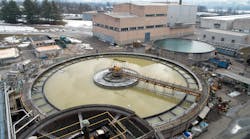Under terms of the Bush Administration’s proposed fiscal year 2007 budget, the Environmental Protection Agency’s (www.epa.gov) funding will be cut by over $300 million (from FY 2006’s enacted level of $7.625 billion to $7.31 billion). In a news release, the National Association of Clean Water Agencies (NACWA, www.nacwa.org) notes that the vast majority of this reduction will be achieved by a proposed cut of approximately $200 million (from $887 million to $687 million) for the EPA’s Clean Water State Revolving Fund (CWSRF) program. The CWSRF, a loan program that helps local communities repair and replace aging treatment plants, has been the primary source of federal support for clean water infrastructure projects since its creation in 1987.
According to NACWA, studies by the EPA, the Congressional Budget Office (CBO, www.cbo.gov), the Government Accountability Office (GAO, www.gao.gov), and the Water Infrastructure Network (WIN, www.win-water.org) estimate a water infrastructure funding gap exceeding $300 billion over the next 20 years. Given this mounting funding gap, the NACWA believes it is untenable for the federal government to cut support for clean water in America. While the NACWA believes that improved utility management and rate increases at the local level are critical to addressing this daunting funding gap, the association is also calling on Congress and the White House to support the recently introduced Clean Water Trust Act of 2005, H.R. 4560. H.R. 4560 would create a deficit-neutral, clean water trust fund to guarantee clean and safe water in America for the long-term.
To achieve these objectives, H.R. 4560 would, according to the NACWA, provide approximately $7.5 billion a year from 2006 to 2010 in loans and grants to cities, counties, towns, and townships to address the backlog of critical clean water projects, meet unfunded mandates, and improve utility management based on state-determined priorities. The Clean Water Trust Act of 2005 also will enhance fisheries, encourage research, spur new technologies, and protect critical regional waters such as the Great Lakes, Chesapeake Bay, and Gulf of Mexico, according to the NACWA.
Responding to the Bush Administration’s action, Ken Kirk, NACWA’s executive director, said, in a prepared statement, "This proposed budget cut to the CWSRF is the wrong measure at the wrong time. Without a long-term, sustainable federal-state-local partnership communities will not be able to tackle essential capital replacement projects needed to meet federal Clean Water Act mandates and improve the quality of the nation’s waters. H.R. 4560, on the other hand, would ensure funding for the CWSRF and guarantee a meaningful federal re-commitment to achieving the lofty goals of the 1972 Clean Water Act."

